Based on the 2012 Grade 10 NSC Exemplar Paper:
Level 1 & 2 Difficulty
Source A:
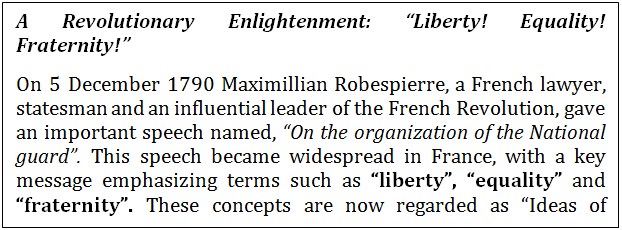
Description of Robespierre’s 1790 speech.
For the source’s online origin, see footnote[1]
1. Explain the ideas of enlightenment from Robespierre’s speech, Source A. (3 x 2 marks)
Liberty
Liberty can be defined as freedom from oppression from a tyrannical ruler, imprisonment or slavery.[2] In the context of the French Revolution it referred to freedom from the monarchy and their oppressive laws, such as imprisonment of any citizen without trial by the Letters de Cachet. French revolutionaries wanted to be independent with self-determination and authority. They no longer wanted to accept the divine rights of their rulers, but rather wanted the people to have a voice of their own. The word “liberty” ultimately meant that they were free from the monarchy with authority and independence in a free France. Their rights could no longer be overruled by a ruler with oppressive laws, such as the Letters de Cachet.
Equality
Before the French Revolution society in France was divided into classes based on the Estate System. This Estate System determined who paid taxes and who had political power. This system enabled the minority to overrule the majority, while the rich could also exploit the poor. When revolutionaries cried for “equality” they protested France’s exploitative social and political structure and economic policies. Equality can be defined as all citizens being equal. However, even during the French revolution, the different estates had different ideas about equality. For example, the Third Estate, which was the paupers consisting of mostly farmers, wanted everyone to be equal. But the bourgeoisie, who was the educated middle class, wanted the same rights and privileges of the Second Estate. They did not want a democracy, where votes counted per head, but a meritocracy. A meritocracy means that people’s ranks and status are determined by education and achievement rather than birth right and privileges. They did not want to share their political power with the poor Third Estate, who were uneducated. This shows that even during the French Revolution the concept of equality did not exactly mean “being equal” amongst the different classes.
Fraternity
The term “fraternity”, which means brotherhood can almost be exchanged for terms such as “nationalism” and “solidarity”. Solidarity means that people are united to fight a common cause. Nationalism in this context, refers to the French population’s loyalty and devotion to their nation and can be defined as a patriotic feeling. During the French Revolution there was increasing empathy for fellow France citizens and the need to fight against the oppressive government collectively. Historians have noted that out of all the concepts, fraternity was the least defined, abstract and unattainable. During the early phase of the revolution, when reform such as the Declaration of the Rights of Man and Citizen were put into place, there was said to have been more unity and brotherhood among the Three Estates. But as the revolution continued this brotherhood deteriorated.
Source B:
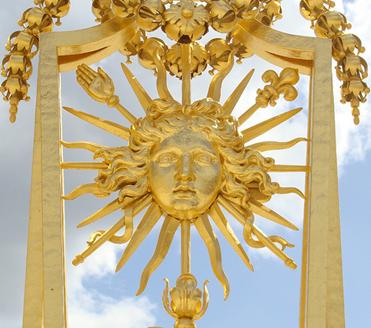
The Sun King Emblem outside the Palace of Versailles. Created by Louis XIV. Louis is painted as Apollo. Image Source
For the source’s online origin, see footnote[3]
2. What was Popular Sovereignty and how did France chose their leaders? (2 x 2 marks)
Monarchs believed that they were divine rulers, elected by God to govern the country. This concept was called the “divine right monarchy”. This proved problematic as the majority of French society were oppressed by their rulers. The rulers were also not held accountable for their actions, as it was believed that one could not question the decisions of a “representative of God”. The concept of popular sovereignty replaced the idea that God chose the rulers, and that government had to be elected by the people with their support and consent. This concept meant that governments could be held accountable by the people and could be removed if they did not listen to them. John Locke and Jean-Jacques Rousseau, two writers and revolutionaries, promoted the concept of popular sovereignty. Particularly, in John Locke’s book, Two Treatises of Government, he claims that all men are born equal and should not be subjected to the oppressive decisions of a monarch.
3. What was the purpose of displaying the emblem in Source B around the Palace of Versailles? (1x 2 marks)
This emblem displays Kind Louis XIV as Apollo, the Sun God. The purpose of displaying these emblems was to remind the people of France that the King was the at the centre of the country.[4] Much like the sun, it is believed that Louis XIV aspired to have people look up to him. The usage of gold is a display of power and wealth. Louis XIV wanted people to recognise him as the King, whose power came directly from God.
Source C:
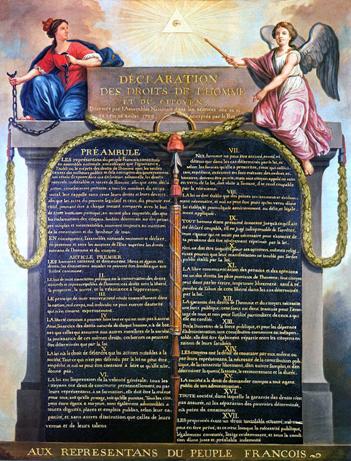
An oil painting by Jean-Jacques-François Le Barbier, representing the ‘Declaration of the Rights of Man and Citizen’. c. 1789. Currently located on display in Rue de Sévigné, Paris.
For the source’s online origin, see footnote[5]
4. What were natural rights that are highlighted in the Declaration of Rights of Man, Source C? (1 x 2 marks)
The idea of natural rights was promoted by John Locke. In his writing, Two Treatises of Government, he explored concepts such as natural laws, which mean they were generally applicable to everyone, and natural rights. Natural rights on the other hand referred to privileges everyone was entitled to from birth. John Locke named three rights as natural rights, namely liberty, property and life. This meant that everyone had the right to own land and to be free from oppressive and unfair persecution or death. During the first phase of the French Revolution this idea was popular among the liberal bourgeoisie and natural law and rights were highlighted in the “Declaration of the Rights of Man and Citizen”.
All these concepts were later called “Ideas of Enlightenment”, as it moved away from ideas of the oppressive Ancien Regime. During the French Revolution new ideologies emerged, such as liberty, freedom and equality that formed the basis of their constitution and protests.
Source D:
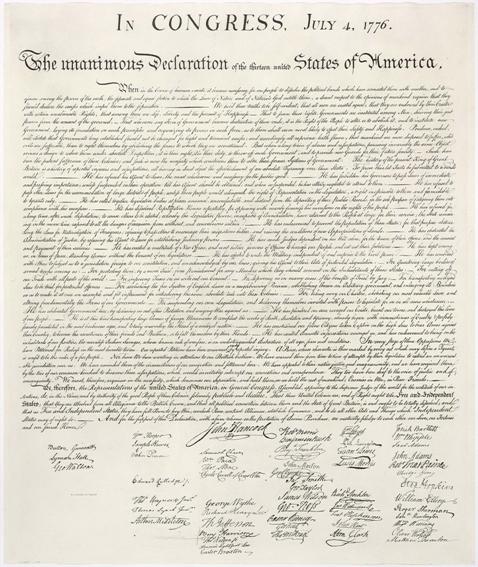
The United States of America’s Declaration of Independence. Signed on the 4th of July, 1776. This document was originally signed by 39 members of congress. This version is a press reproduction that was made by William Stone in 1823
For the source’s online origin, see footnote[6]
Source E:
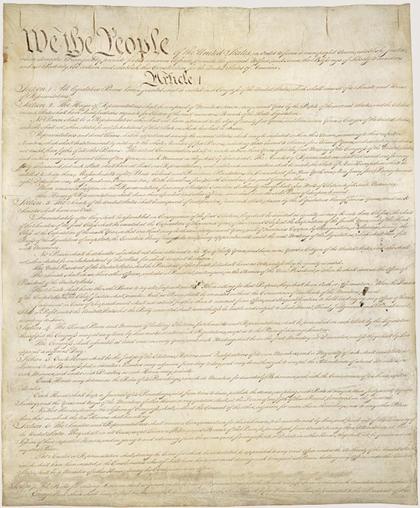
The American Constitution. This version of the document was engrossed by Jacob Shallus on the 27th of September, 1787. It was signed by 39 members of congress.
For the source’s online origin, see footnote[7]
5. How did the American war of Independence and American Revolution (1765-1783) influence the French Revolution? (4 x 1 marks)
The American War of Independence showed people around the world that it was possible to have autonomy and independence. In this war, North America declared themselves free from British rule.[8] The American War of Independence had ideological beliefs that would later surface in the French Revolution. These include the beliefs of liberty, equality and fraternity.[9] A major component of the War of Independence was the signing of the Declaration of Independence and the American Constitution. Through a democratic system, laws to govern the United States of America were established. It could be argued that this later influenced the constitutional principles that France’s Third Estate adopted.
6. What is constitutionalism, as evidenced in Source E? (1 x 2 marks)
Constitutionalism is defined as being ruled by a constitutional government and adhering to their constitutional principles. During the American Revolution, the United States Constitution was drafted in 1787, which emphasized terms such as popular sovereignty, natural rights and separation of power. French society was inspired by the American Revolution and wanted to implement the same constitutional principles in their society. In June 1789, the Third Estate pledged that they would remain in the Assembly till France had its own Constitution, with a written framework defining the powers and structures of the state. They wanted rulers to be accountable by removing their absolute power. They believed a constitution would bring an end to government’s abuse of power.
Level 3 Difficulty
7. Assess Source D for reliability. (4 x 1 Marks)
Source D is partially reliable regarding the creation of the declaration of independence. It is a primary source. The original document was created on the 4th of July, 1776. This version of the document is a reproduction that was made by William Stone in 1823. There is a large amount of time that between the original production and the reproduction. Although it is a reproduction, the handwriting has remained intact. This source was created from the perspective of Americans. This source was a legal document, it therefore serves the purpose of documenting an agenda. The source intended on retaining this declaration, so that it could later be used in legislature to build an independent country. The source has signatures from 39 members of congress, thus allowing the historian to trace witnesses to the incident.
Source F:
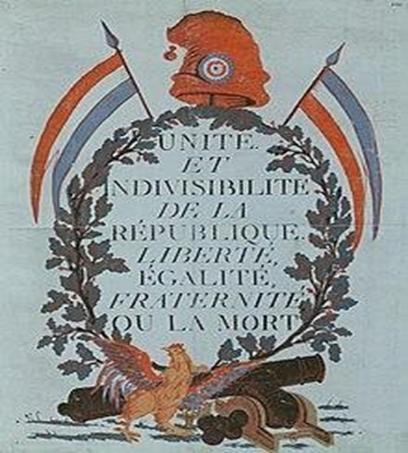
Propaganda poster used during French Revolution in 1793. The text reads: “Unity and Indivisibility of the Republic. Liberty, Equality, Fraternity or Death”
For the source’s online origin, see footnote [10]
8. Analyse the poster in Source F
TIP: When looking at posters, students need to pay attention to images, colours, dates, characters and references to places.
ANOTHER TIP:Use present tense when referring to the content in visual sources.
1. What is the central purpose of the poster? (2 x 1 mark)
One could speculate that this poster was used by the Third Estate to encourage people to join the revolution. This poster aims to spread the ideas of enlightenment and to bolster support for the revolutionaries.
2. Which ideas does the poster text point to? (1 x 1 mark)
Text in the poster points to the ideas of enlightenment. These include the beliefs of liberty, equality and fraternity.
3. Identify symbols in the poster. (4 x 1 marks)
- This poster has the French flag that is mirrored on either side of the poster. The flag represents the French people, and has strong nationalist sentiments.
- The poster has a laurel wreath that is supporting the flags. Historically, wreaths have been used to signify heraldry. In this poster, it is used as a symbol to denote the duty of the French people.
- Right on top of the wreath is a Phrygian cap. This symbol comes from roman iconography and is known as a liberty cap.
- Below the wreath, there is a gallic rooster, whose wings are the same colour as the French flag. A gallic rooster is an unofficial symbol of France as a nation.
4. What does the propaganda in the poster want their audience to believe and do? (1 x 1 mark)
This poster is calling the French people to action, it is encouraging them to join the revolution. Next to the rooster, which represents the nation, is a cannon. The poster is encouraging the French nation to take up arms.
5. Would this poster have been effective at the time? (1 x 1 mark)
Yes, this poster would have been effective at the time of the French Revolution. It plays to strong elements of nationalism and clearly indicates the ideological beliefs that were trademarks of the revolution.
Source G:
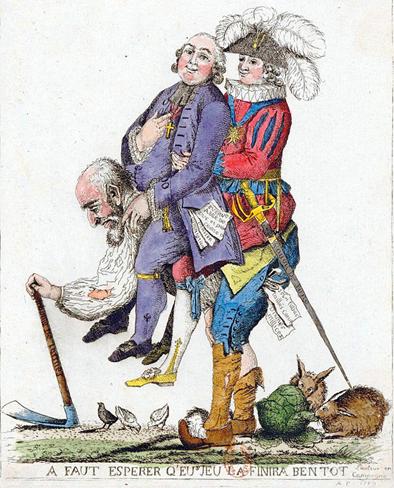
A political cartoon from France in 1789.
For the source’s online origin, see footnote[11]
9. Explain the message in the cartoon in Source G. Use the visual clues to support your answer. (1 x 2 marks)
The cartoon shows how the third estate, represented here by a peasant, is supporting the second and first estate. The peasant bears the physical burden of the clergy and nobility. He is working hard, while the other two reap the rewards of his efforts. Visual clues of this are seen in the way that the peasant piggy backs the other two, he is bent over and is not smiling.
Source H:
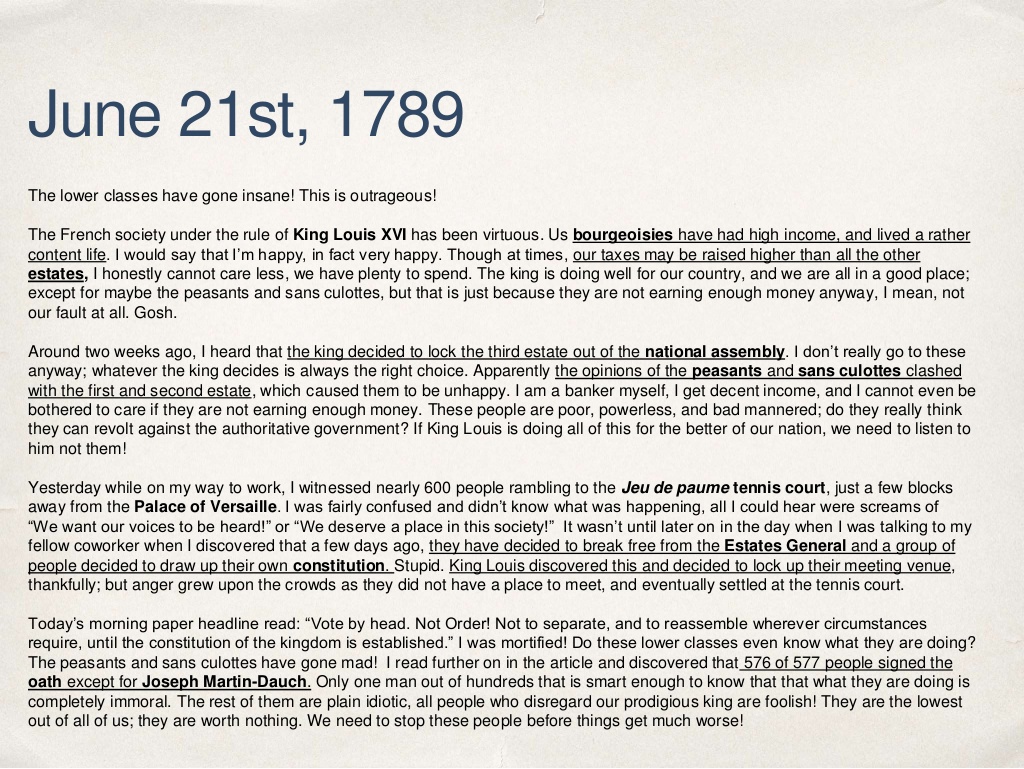
A Journal Entry on 21 June 1789.
For the source’s online origin, see footnote[12]
10. Analyse the Journal in Source H
10.1. How useful is this source when analysing the events and atmosphere of the French Revolution? (2 x 2 marks)
This source is useful to an extent. It is a subjective experience that gives a different perspective on the monarchy and the conditions of France. This source may not give an accurate account of how the majority of the people felt in France, but it is still report how people acted and felt, even if the witness does not feel the same way.
The source also shows that the richer classes were more privileged. The writer states that they are a banker, who could not care less about the living conditions of the poor and powerless. It is out of his privilege that he refers to the revolutionaries as bad mannered. It portrays how oblivious the rich were to the conditions of the poor.
10.2. Would you view this as a reliable and accurate representation of how people felt in France? Explain why you agree or disagree. (4 x 1 marks)
This source does not reflect the reality of the harsh conditions people faced in France during the French Revolution. Poor harvests, unwise economic policies and debt left the majority of the French population starving. The bourgeoisie questioned the decisions of the king and the ideas of equality, liberty and fraternity became widespread. This source does not represent these facts but aims to present the monarchy in the best light possible. The author of the journal does not appear to be critical of the king, but rather accustomed to the idea of “divine rule” as he truly believes that the king always make wise decisions that should not be questioned. Therefore, the author of the journal does not give a reliable representation of how people felt in France as he does not address the unwise decisions of the monarchy, only the reactions of the people he describes as irrational.
The journal entry also seems to have been written on 21 June 1789, which would have made the account more reliable. However, the language used creates uncertainty whether it was truly written during the 1700’s. The language used could have been affected by translating a French account to English. This could affect the accuracy and reliability of the account.
Source I: Lyrics of “The Charmagnole”
(date of release: 1792 – 08 – 00)
Translated version (from French to English)
Madame Veto has promised
Madame Veto has promised
To cut everyone’s throat in Paris
To cut everyone’s throat in Paris
But she failed to do this,
Thanks to our cannons
Refrain
Let us dance the Carmagnole
Long live the sound
Long live the sound
Let us dance the Carmagnole
Long live the sound of the cannons
Mr. Veto had promised (repeat)
To be loyal to his country; (repeat)
But he failed to be,
Let’s not do quarters.
Refrain
Antoinette had decided (repeat)
To drop us on our asses; (repeat)
But the plan was foiled
And she fell on her face.
Refrain
Her husband, believing himself a conqueror, (repeat)
Knowing little our value, (repeat)
Go, Louis, big crybaby,
From the Temple into the tower.
Refrain
The Swiss had promised, (repeat)
That they would fire our friends, (repeat)
But how they have jumped!
How they have all danced!
Refrain
When Antoinette sees the tower, (repeat)
She wishes to make a half turn, (repeat)
She is sick at heart
To see herself without honor.
Refrain.
Refrain.
Refrain.
For the source’s online origin, see footnote[13]
11. Analyse the Journal in Source I
11.1. Compare Source H and I. How does the two sources portray the monarchy? (2 x 2 marks)
In source H King Louis XVI is portrayed as a virtuous ruler, who always made the right choices and enabled everyone in France to prosper besides the peasants. The monarch is portrayed as a true leader that focuses on what is best for the nation and confirms that people in the country needs to listen to the king.
In Source I the monarchy is defeated. The people joyously sing that their monarchs are dethroned and that the nation of France’s cannons had brought their monarchs to justice. The monarchs are portrayed as being disloyal to their people, as they did not fulfil their needs. The monarchs are also portrayed as being self-centred and indulging in extravagant lifestyles at the cost of the starving population of France. The lyrics read: “Antoinette had decided to drop us on our asses” In contrast with source H, King Louis is not portrayed as a virtuous ruler, that makes the right choices, but rather a cry baby who thinks of himself as a conqueror, but is ultimately governed by his wife.
Finally, all the honour and divine rule the monarchy had in source H is stripped away in source I when it reads: “When Antoinette sees the tower, she wishes to make a half turn, she is sick at heart to see herself without honour.”
Source J:
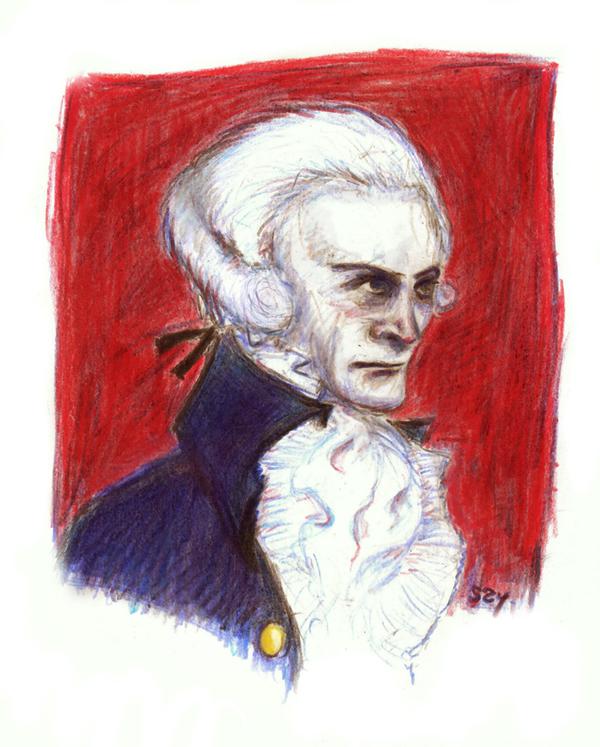
Portrait of Robespierre.
For the source’s online origin, see footnote[14]
12. Analyse the Portrait in Source J
12.1. How is Robespierre portrayed? (1 x 2 marks)
Maximilien Robespierre’s facial expression is angry, violent and bitter. His eyebrows look condescending and his eyes are looking upwards in anger. His lips are compressed which shows dislike and anger. The red background also reinforces the idea of violence and bloodshed.
12.2 Why do you think Robespierre was portrayed in such a manner? Draw on background knowledge of who Robespierre was. (2 x 2 marks)
Robespierre is remembered for his “Reign of Terror” which started on 5 September 1793 and continued till 27 July 1794.[15] During his time as the leading member of the Committee of Public Safety, Robespierre beheaded approximately 17 000 enemies of the French Revolution.[16] The enemies of the French Revolution refer to nobles and priests who did not support the revolution. France became a blood bath and the French population decided that they would overthrow Robespierre. On 27 July 1794 Robespierre was arrested.[17]
It is against this background that one can understand why the artist portrayed Robespierre as angry, violent and bitter. Robespierre showed no mercy to the enemies of the Revolution and this is depicted in his frown, dark eyes, compressed lips and red background on the portrait.
Medium-length Questions
1. What is a Revolution?(15 Marks)
A revolution refers to a sudden and often violent overthrow of a social system or government to replace the previous order with a new system. Usually revolutions start when people are dissatisfied for a long period of time. They see no alternatives other than overthrowing their leaders. Following a revolution, a new ruling system is established.
Originally revolutions were identified as class-based revolts from the poorer classes who aimed to change the class structure and the way their countries were governed. But the term revolution has broadened to include different types of revolutions, such as elite, political, social, great and failed revolutions. Revolutions can also unfold differently and be caused by different classes or actors. The French Revolution is an example of a great revolution. This means that the actors involved in the revolution changed the social, economic and political structures in the country. In contrast, a political revolution only changes the state institutions. Social and elite revolutions are the exact opposite of each other. While social revolutions are revolts led by lower classes, elite revolutions are led by the upper classes. Finally, there are failed revolutions, which entail mass-mobilization of protestors, yet they fail to change the political, social or economic order.
There are also various causes of revolutions. It can occur due to masses uprising against oppression from the government, economic hardships, such as food shortages and rising poverty, social antagonisms between different groups, which occurred between the aristocracy and bourgeoisie during the French Revolution, and exposure to new ideas. All of these causes can lead to a revolutionary situation, where revolting groups are disloyal and disobedient to the government’s commands. Usually, this results in a situation where there is dual or multiple sovereignty with each exercising control over the government, until one has complete control. In the case of the French Revolution, the bourgeoisie divided the country as they disobeyed the aristocracy, questioned their power and finally took charge of the country.
Further short & medium length questions to explore:
- What impact did France’s revolutionary ideas have on the rest of the world?
- What was the reaction against democracy and the modernisation of France after the revolution?
- What happened when the Estates General met at the Palace of Versailles in 1789?
- Which factors led to the formation of the National Assembly?
Case Study (8 Mark Source Based Question)
The spread of revolutionary aspirations. Liberty and slavery in the French colonies: Haiti and Toussaint L ‘Ouventure.
Tips & Notes:
- Check out our Source Analysis and Source Based Questions packs for more tips.
- Remember, these are just examples. You still need to use the work provided by your teacher or learned in class.
- It is important to check in with your teacher and make sure this meets his/her requirements.
This content was originally produced for the SAHO classroom by
Ilse Brookes, Amber Fox-Martin & Simone van der Colff
[1] Author Unknown, “What was the meaning of the French motto “Liberty, Equality, Fraternity, or Death”, during the French Revolution?”, eNotes, (Uploaded: 26 February 2016), (Accessed: 5 May 2020), Available at: https://www.enotes.com/homework-help/what-was-meaning-french-motto-liberty-equality-636194
[2] Tulloch, S. Readers Digest Complete Word finder, 880.
[3] L. Neutonic, The Sun King Emblem. Available at: https://learnodo-newtonic.com/louis-xiv-facts/the-sun-king-emblem-at-the-palace-of-versailles. Accessed 25 May 2020.
[4] O. Jarus., Palace of Versailles: Facts and History. (Uploaded Oct 5 2017), available at: https://www.livescience.com/38903-palace-of-versailles-facts-history.html. (Accessed 25 May 2020).
[5] J. J. F. Barbier, Representation of Declaration of Rights of Man, 1789, 1789, (Uploaded 13 05 2013), (Accessed 25 May 2020), available at:
https://en.wikipedia.org/wiki/File:Declaration_of_the_Rights_of_Man_and_of_the_Citizen_in_1789.jpg
[6] W. Stone. The Declaration of Independence. (1823). Available at: https://en.wikipedia.org/wiki/United_States_Declaration_of_Independence#/media/File:United_States_Declaration_of_Independence.jpg
[7] America’s Founding Documents, 17 September 1787. (Accessed 25 May 2020). Available at: https://www.archives.gov/founding-docs/constitution.
[8] N. Worden, J. Bottaro, P. Visser, P. “In Search of History: Grade 10 Learner’s Book”.
[9] Ibid.
[10] Author Unknown, “Liberte, Egalite, Fraternite”, Wikipedia, (Uploaded: Unknown), (Accessed: 5 May 2020), Available at: https://en.wikipedia.org/wiki/Libert%C3%A9,_%C3%A9galit%C3%A9,_fraternit%C3%A9
[11] Bibliothèque nationale de France, “You should hope that this game will be over soon.” The Third Estate carrying the Clergy and Nobility on its back, 1789. Available at: https://en.wikipedia.org/wiki/File:Troisordres.jpg
[12]Source: Joanne Wang, “Alexis Rolande’s Journal (French Revolution (1789 – 1799)”, Slideshare, (Uploaded: 1 March 2015), (Accessed 3 May 2020), Available at: https://www.slideshare.net/joannewang329/french-revolution-journal-entries-46049241
[13]Author Unknown, “The Charmagnole”, Liberty, Equality, Fraternity: Exploring the French Revolution, (Accessed: 3 June 2020) Available at: https://revolution.chnm.org/items/show/621
[14]Joanne Wang, “Alexis Rolande’s Journal (French Revolution (1789 – 1799)”, Slideshare, (Uploaded: 1 March 2015), (Accessed 3 May 2020), Available at: https://www.slideshare.net/joannewang329/french-revolution-journal-entries-46049241
[15] Author Unknown, “Reign of Terror”, Encyclopaedia Britannica, (Uploaded: 24 January 2020), (Accessed: 6 May 2020), Available at: https://www.britannica.com/event/Reign-of-Terror
[16] Ibid.
[17] Author Unknown, “Reign of Terror”, Encyclopaedia Britannica, (Uploaded: 24 January 2020), (Accessed: 6 May 2020), Available at: https://www.britannica.com/event/Reign-of-Terror